What Are "Superlice"?
Superlice are head lice that have genetically mutated to become resistant to the active ingredients in some traditional lice treatment products. Superlice do not look any different from regular lice. They can only be identified by their resistance to traditional lice treatments.
98.3% of lice collected in 48 states from July 22, 2013 to May 11 2015 were identified as pesticide-resistant "superlice".*
-
What are the symptoms of superlice?
The symptoms of all kinds of head lice include the feeling of something moving in the hair, an itchy scalp, irritability, and difficulty sleeping. Superlice and regular lice only differ in their response to treatment. If lice are still present after treating with a traditional over-the-counter product, they may be superlice. Nix® Ultra is highly effective for killing lice, superlice and their eggs.
-
How do superlice spread?
Superlice and regular lice spread through direct contact with the hair of an infested patient. Head lice move by crawling, but they cannot not hop or fly. Lice can also spread by sharing clothing or hair accessories recently worn by a person with lice. Dogs, cats and other pets cannot spread lice.
-
How do I check my children for superlice?
If you suspect that your child has head lice, there are a few easy steps you can follow to confirm that you need to begin treatment. Once you determine that it is, in fact, lice, you'll want to act quickly to kill the lice, remove the nits and stop the problem from spreading.
Gather these tools together to help you determine if your child has lice and, if they do, make it easier to treat them ASAP.
- Magnifying glass
- An old towel
- Hair clips
- Tissues
- A timer
- A sealable plastic bag
- Disposable gloves
- Something to keep your child busy (movie, game, etc.)
Check, then Treat
- Inspect the Hair: Use the Nix® Premium Metal Two-Sided Comb and a magnifying glass to look closely at the scalp. Start at the base of the neck and divide the hair into small sections as you search for adult lice and their nits (eggs).
- What to look for: Sometimes, it’s difficult to tell whether you are seeing lice or just some other scalp condition like dandruff, or even dirt. Adult lice are usually light brown in color and look like sesame seeds. They often move quickly and can be found on the scalp or hair. Eggs (nits) are yellow, brown, or tan. They look like tiny seeds and are firmly attached to the hair shaft. They do not move.
-
Do superlice pose any danger to my child?
Aside from being an annoyance, superlice are no more dangerous than regular lice, and can be treated with a safe, non-toxic and pesticide-free remedy such as Nix® Ultra All-in-One Shampoo.
-
How are lice and superlice prevented?
Head lice are spread very easily in schools, at playgrounds and in daycares, making lice difficult to prevent. The American Academy of Pediatrics recommends teaching children not to share hats, combs or other items that come into contact with hair. Kids should also be checked for lice if there is an outbreak at their school, even if they aren’t showing any signs of symptoms (e.g., itching, irritability).
To protect your child and family from a lice outbreak check-out Nix® Lice Prevention Daily Leave-In Spray which offers long last protection against lice and superlice.
Learn more about Nix Lice Prevention Spray here.


